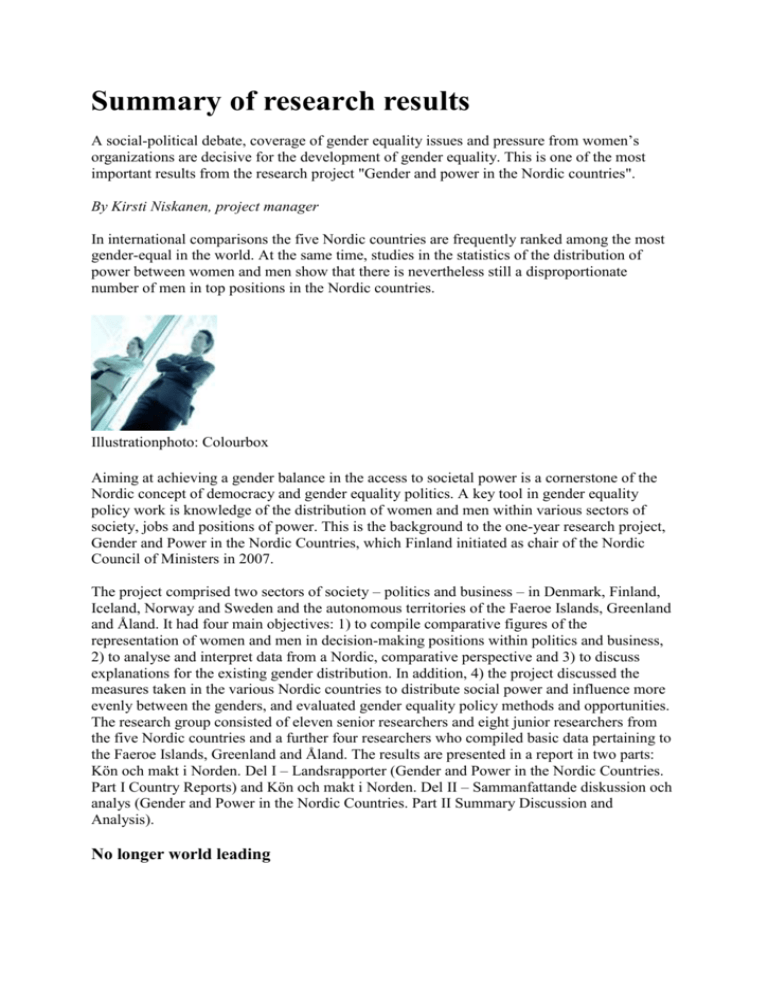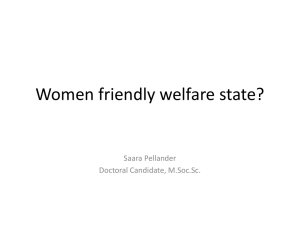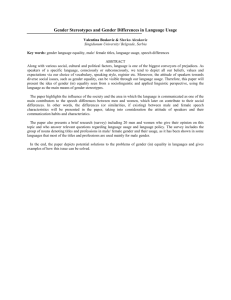a summary of the research results in English
advertisement

Summary of research results A social-political debate, coverage of gender equality issues and pressure from women’s organizations are decisive for the development of gender equality. This is one of the most important results from the research project "Gender and power in the Nordic countries". By Kirsti Niskanen, project manager In international comparisons the five Nordic countries are frequently ranked among the most gender-equal in the world. At the same time, studies in the statistics of the distribution of power between women and men show that there is nevertheless still a disproportionate number of men in top positions in the Nordic countries. Illustrationphoto: Colourbox Aiming at achieving a gender balance in the access to societal power is a cornerstone of the Nordic concept of democracy and gender equality politics. A key tool in gender equality policy work is knowledge of the distribution of women and men within various sectors of society, jobs and positions of power. This is the background to the one-year research project, Gender and Power in the Nordic Countries, which Finland initiated as chair of the Nordic Council of Ministers in 2007. The project comprised two sectors of society – politics and business – in Denmark, Finland, Iceland, Norway and Sweden and the autonomous territories of the Faeroe Islands, Greenland and Åland. It had four main objectives: 1) to compile comparative figures of the representation of women and men in decision-making positions within politics and business, 2) to analyse and interpret data from a Nordic, comparative perspective and 3) to discuss explanations for the existing gender distribution. In addition, 4) the project discussed the measures taken in the various Nordic countries to distribute social power and influence more evenly between the genders, and evaluated gender equality policy methods and opportunities. The research group consisted of eleven senior researchers and eight junior researchers from the five Nordic countries and a further four researchers who compiled basic data pertaining to the Faeroe Islands, Greenland and Åland. The results are presented in a report in two parts: Kön och makt i Norden. Del I – Landsrapporter (Gender and Power in the Nordic Countries. Part I Country Reports) and Kön och makt i Norden. Del II – Sammanfattande diskussion och analys (Gender and Power in the Nordic Countries. Part II Summary Discussion and Analysis). No longer world leading The project used a broad definition of its two target areas, politics and business. We studied national politics, the presidential elections in Finland and Iceland, governments, international politics/foreign policy, regional/local politics and, to a certain extent, public administration. As to the corporate sector, the project studied companies listed on the stock exchange and state companies, financially oriented authorities and, to some extent, also financial organizations. A first observation is that it is no longer a given that the Nordic countries are in the forefront when it comes to gender equality development in parliamentary representation. From a global perspective, a post-conflict country such as Rwanda with its female majority in parliament, has superseded all the Nordic countries in terms of gender equality in that area (regardless of all other differences). And several countries in the global South (South Africa, Argentina, Costa Rica) with a female proportion in parliament of over or just under 40 per cent, are coming into line with the Nordic countries. The previous Nordic comparative study was published ten years ago. At that time, the female proportion in the Nordic parliaments was between 25 and 43 per cent, and the Nordic countries appeared to be the most gender-equal region in the world. Today women make up between 37 and 47 per cent of the members of parliament in the Nordic countries, but, as seen above, this region is no longer evidently world leading in this respect. Other countries are reaching the same level and challenge the Nordic self-image as the most gender equal region in the world. Another finding of the project is that the problems of gender equality are far from solved within Nordic politics. The area of local government is one example of this. In all the Nordic countries, political representation is less gender-equal in local government than at the national level. The proportion of women in the local governing bodies varies between 32 per cent in Denmark and 42 per cent in Sweden. The lack of gender equality is even clearer when looking at the management of the municipalities. There, male dominance is still very strong. For example, the proportion of female leaders in local government is as low as between 20 and 32 per cent in Finland, Iceland, Norway and Sweden. Denmark is a special case where the strong male dominance among the mayors was further strengthened after the local government reform in 2006. Today there are only 14 per cent women at this political level in the Danish municipalities. Increase in female ambassadors Illustrationphoto: Colourbox One area seldom included in gender equality discussions, but where we observe interesting changes, is diplomacy. The proportion of female ambassadors (excluding ambassadors to international bodies) in Denmark, Finland, Iceland and Norway has increased from very low numbers (between 3 and 10 per cent in the mid–1990s) to about 15 percent in Denmark and Iceland and to about 30 per cent in Finland and Norway. The Swedish figures also indicate a growing trend: the proportion of women as heads of embassies and ambassadors to international bodies has increased from 10 to about 30 per cent since the mid–1990s. This indicates that the situation within the foreign policy administration might be changing. In Finland women have been over-represented at the Foreign Ministry trainee courses in the 2000s. In Norway the gender distribution among the trainees has been relatively balanced. A general impression provided by our surveys is that the decisive difference is that between visible positions, which are thus sensitive to observation, as for example in parliamentary politics, and less visible positions where gender equality issues are not observed as intensively or not at all. Men still dominate the business sector A further important – but hardly surprising – result of the project is the continued male dominance of the business sector. The project focussed on companies listed on the stock market and state-owned companies and their management structures, but did not study other parts of the corporate sector in the Nordic countries. As far as possible, the researchers have also compared changes over time. Our results show that there has been progress, while there are, however, considerable differences between the countries. The proportion of women on the boards of listed companies is today between 7 and 36 per cent, as compared to 4–9 per cent in the late 1990s. The numbers are higher in state-owned companies, since these are usually regulated by the Nordic gender equality legislation stipulating that at least 40 per cent of each gender must be represented on boards and in leading positions. In state-owned companies, women make up between 26 and 46 per cent of the board members, compared to 20–30 per cent ten years ago. So, it is obvious that politics contribute to increasing gender equality within the business sector. The situation is best in Norway, where the law on gender quotas has increased the proportion of women also on the boards of companies listed on the stock exchange to 36 per cent in five years, from nine per cent in 2004. Sweden is second best; there, the threat of a gender quota law and the so-called code of conduct has resulted in an increase of the proportion of women on the boards of listed companies to 19 per cent in 2008 from 4 per cent in the late 1990s. Illustrationphoto: Colourbox However, the picture is less bright in Norway and Sweden if we look at the management structures of listed companies. There are very few women in the position of CEO, or members of management groups. Between 93 and 97 per cent of all CEOs and between 85 and 90 per cent of the management group members of listed companies are men. The conclusion is that although a gender equality discussion has started within the business sector, and although the state-owned companies have shown the way, there is still a long way to go before we start seeing serious results in the private corporate sector. Gender equality measures within the world of business are often – with the exception of the Norwegian quotas in public joint stock companies – aimed at increasing the number of female managerial candidates. Such measures might be important for individual women and improves the gender equality climate in individual enterprises. However, it remains to be seen when the business sector starts actively seeking female leaders, as the world of politics does today. Horizontal segregation a challenge Parliamentary politics in the Nordic countries is a gender equality success, if a representation of 40–60 per cent of each gender is regarded as gender balanced. The current governments of the countries are gender balanced in this sense, as is the proportion of women and men in the parliamentary committees and most other leading positions in the parliaments. There are female party leaders in all of the Nordic countries today – also in some of the largest parties – and we have seen female ministers in traditionally male dominated posts, such as defence policy, finance and industry, and foreign affairs. State companies and the Norwegian public joint stock companies are in the vanguard of increased gender equality in the world of business. The gender equality problems in these fields are caused by subtler, but systematic differences. Women and men are seen to hold different functions and positions, within both politics and business. Most commonly, men are over represented and women under represented in political areas such as defence, finance and industrial policy. The opposite is true of areas such as social issues, culture, education and gender equality. One example can be taken from parliamentary committees. When looking at the gender distribution in the committees, and in which of them women make up 50 per cent or more of the members, we find that sociocultural functions, such as culture and education, are more or less always female issues, and the prestigious areas, such as finance and industrial policy, are dominated by men. In addition, women form the majority in the committees in areas such as the labour market (Denmark and Sweden), environmental issues (Finland and Iceland), justice (Norway and Sweden) and foreign policy (Iceland and Norway). It is more difficult to survey the horizontal division of gendered labour in the corporate world. But our preliminary results indicate that there are larger proportions of women on corporate boards within finance and business services and in the health sector. Earlier research also shows that men are over represented and women under represented as middle managers in posts from whence CEOs are recruited. Debate and pressure decisive What, then, does actually promote gender equality? One of the project’s most important results is that the maintenance of a social-political debate on the subject, as well as coverage of gender equality issues and pressure from women’s organizations (both within and outside of the political parties) are decisive for the development of gender equality. The results of the project show that legislations (or in the case of Sweden, recommendations) that since the latter half of the 1980s have prescribed a gender-balanced representation on public committees, commissions and boards, have had an impact. This is proved by the relatively even gender balance in parliamentary bodies and state companies, provided that the ministers in charge monitor the observance of the laws. In Finland and Norway the regulations have been extended to pertaining also to corresponding bodies within the municipalities. Since the 1970s and 1980s,pressure from feminist debaters and women’s organizations has also more or less forced the political parties to adjust their internal party democracy and nomination practices. The parties play a crucial role in the development of gender representation, since the parties nominate the candidates that the voters can choose from, and place them in eligible or non-eligible positions on their lists. Illustrationphoto: Colourbox Party quotas (quotas for the parties’ internal bodies) and candidate quotas have been introduced in all countries, except for Finland, by the central and left wing parties. (In Denmark, some parties applied gender quotas, but they were soon abandoned.) The competition between the parties and the gender equality debates that the measures have generated have, in turn, forced the whole political spectrum to actively discuss and take a stance on issues of representation. There has not been similar pressure from women’s movements as to the appointment of corporate board members within the world of private enterprise. Consideration for the autonomy of industry and respect for private self-governance has put limits to the gender equality discussion. Conclusions and suggested further research One important conclusion from the project Gender and Power in the Nordic Countries is that there are gaps in the public statistics in all countries, which makes it impossible to follow the development of gender equality within politics and business in a structured way. This concerns, for example, certain areas of parliamentary politics in Denmark, local government and public administration in all countries, as well as the private corporate sector. Another, theoretically important conclusion is that numeric gender equality, or equal representation of women and men at the same level, can lead to stratifying and status differences by women and men dominating different functions and working within different areas. Finding indicators for measuring and evaluating horizontal segregation is a challenge for gender equality research. A third conclusion, and a task for future research, is to survey and assess the gender equality consequences of various quota measures. On the one hand, quotas (voluntary and statutory) have proven to be efficient openings for a more balanced distribution of power. On the other, wide-spread gender equality has also been reached without quotas, for example within parliamentary politics in Denmark and Finland. Thus, a more varied discussion and researchbased knowledge on various gender equality measures and their impacts, including different forms of quotas, is urgently needed.







